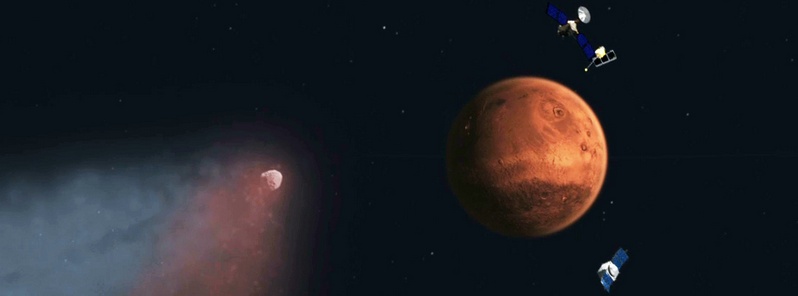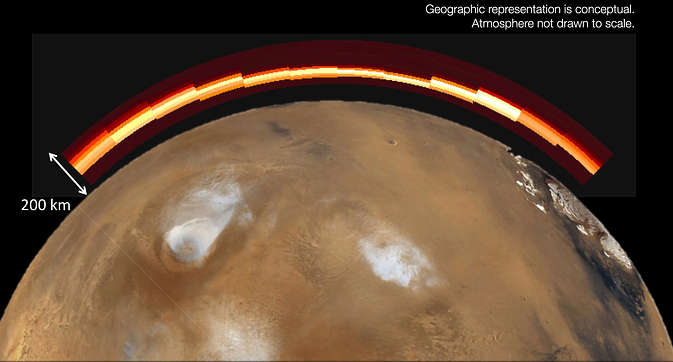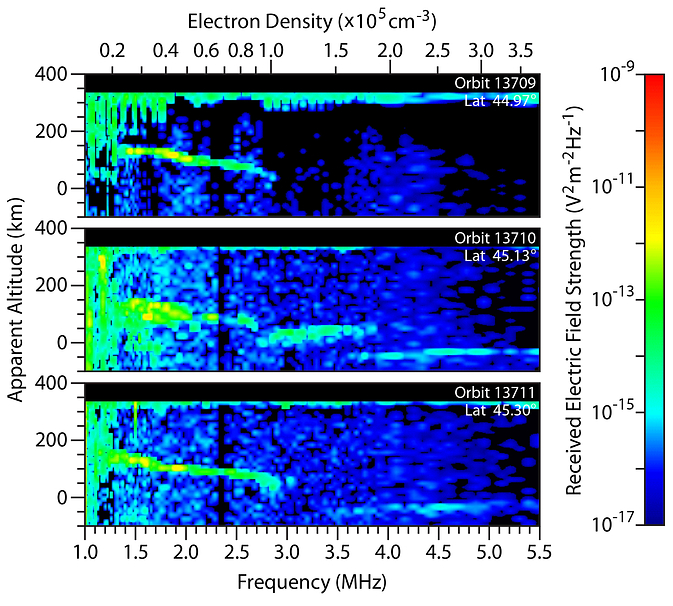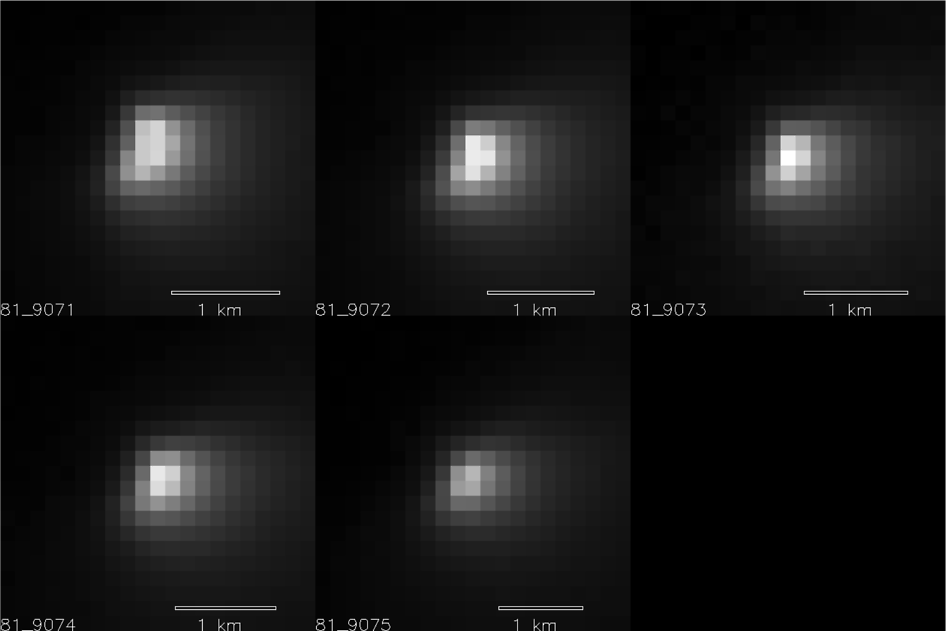Siding Spring’s flyby effects on Martian atmosphere revealed

Two NASA and one European spacecraft that obtained the first up-close observations of a comet flyby of Mars on October 19, 2014 have gathered new information about the basic properties of the comet’s nucleus and directly detected the effects on the Martian atmosphere. The observations were presented in a press conference held by NASA today.
Data from observations carried out by NASA's Mars Atmosphere and Volatile Evolution (MAVEN) mission, NASA’s Mars Reconnaissance Orbiter (MRO), and a radar instrument on the European Space Agency's (ESA’s) Mars Express spacecraft have revealed that debris from the comet added a temporary and very strong layer of ions to the ionosphere, the electrically charged layer high above Mars.
In these observations, scientists were able to make a direct connection from the input of debris from a specific meteor shower to the formation of this kind of transient layer in response; that is a first on any planet, including Earth.
Comet C/2013 A1 Siding Spring traveled from the most distant region of our solar system, called the Oort Cloud, and made a close approach around 18:27 UTC within about 139 500 km (87 000 miles) of the Red Planet.

Dust from the comet impacted Mars and was vaporized high in the atmosphere, producing what was likely an impressive meteor shower. This debris resulted in significant temporary changes to the planet’s upper atmosphere and possible longer-term perturbations. Earth-based and a host of space telescopes also observed the unique celestial object.
“This historic event allowed us to observe the details of this fast-moving Oort Cloud comet in a way never before possible using our existing Mars missions,” said Jim Green, director of NASA’s Planetary Science Division at the agency’s Headquarters in Washington. “Observing the effects on Mars of the comet's dust slamming into the upper atmosphere makes me very happy that we decided to put our spacecraft on the other side of Mars at the peak of the dust tail passage and out of harm's way.”
The MAVEN spacecraft, recently arrived at Mars, detected the comet encounter in two ways. The remote-sensing Imaging Ultraviolet Spectrograph observed intense ultraviolet emission from magnesium and iron ions high in the atmosphere in the aftermath of the meteor shower. Not even the most intense meteor storms on Earth have produced as strong a response as this one. The emission dominated Mars' ultraviolet spectrum for several hours after the encounter and then dissipated over the next two days.


Elsewhere above Mars, a joint U.S. and Italian instrument on Mars Express observed a huge increase in the density of electrons following the comet's close approach. This instrument, the Mars Advanced Radar for Subsurface and Ionospheric Sounding (MARSIS), saw a huge jump in the electron density in the ionosphere a few hours after the comet rendezvous. This spike occurred at a substantially lower altitude than the normal density peak in the Martian ionosphere. The increased ionization, like the effects observed by MAVEN, appears to be the result of fine particles from the comet burning up in the atmosphere.


These three plots are spectrograms showing the intensity of radar echo in the Martian
far-northern ionosphere at three different times on Oct. 19 and 20, 2014. The middle plot reveals effects attributed to dust from a comet that passed near Mars that day. The data are from the Mars Advanced Radar for Subsurface and Ionospheric Sounding (MARSIS), an instrument on the European Space Agency's Mars Express orbiter.
The horizontal axis is the radio-wave frequency of pulses emitted by MARSIS. The vertical axis is the altitude above the Martian surface, as estimated based on the time delay between transmitting the pulse and receiving its reflected signal. The apparent altitude has been computed with an assumption that the radar signal propagates at the speed of light, uncorrected for dispersion and other effects. Increasing intensity is indicated by color-coding from blue to red, as shown by the scale on the right.
All three spectrograms were collected as the orbiter passed overhead at about 84 degrees north latitude.
The top spectrogram shows conditions a few minutes before comet C/2013 A1 Siding Spring sped within about 87,000 miles (139,500 kilometers) of Mars. Except for a weak echo below 1.5 megahertz at about 93 miles (150 kilometers) altitude, no other echoes can be seen. This is typical of the night side of Mars, where little ionization is expected because of the absence of solar illumination.
The middle one, from about seven hours later, shows a new, temporary layer of enhanced electron density within the ionosphere. The layer was at an altitude of about 50 miles (80 kilometers), extending to about 4.6 megahertz, with an electron density of about 260,000 electrons per cubic centimeter. Densities this high have never previously been detected by Mars Express on the night side of Mars.
The bottom spectrogram, from another seven hours later, shows that the temporary layer had cleared away. Researchers attribute the temporary layer to heating caused by high-velocity entry into the Martian atmosphere by fine dust particles that were released by the comet.
Image credit: ASI/NASA/ESA/JPL/Univ. of Rome/Univ. of Iowa
MRO’s Shallow Subsurface Radar (SHARAD) also detected the enhanced ionosphere. Images from the instrument were smeared by the passage of the radar signals through the temporary ion layer created by the comet's dust. SHARAD scientists used this smearing to determine that the electron density of the ionosphere on the planet's night side, where the observations were made, was five to 10 times higher than usual.


Five images of comet C/2013 A1 Siding Spring taken within a 35-minute period as it passed near Mars on Oct. 19, 2014, provide information about the size of the comet's nucleus. These observations by the High Resolution Imaging Science Experiment (HiRISE) camera on NASA's Mars Reconnaissance Orbiter suggest that the nucleus is smaller than 1.2 miles (2 kilometers) across.
HiRISE acquired these images from distances ranging from 86,000 to 93,000 miles (138,000 to 150,000 kilometers) away from the nucleus, as comet Siding Spring made its closest approach to Mars. At those distances, each pixel covers an area from about 450 to 580 feet (138 to 177 meters). The scale bar on each image is 0.62 mile (1 kilometer). Image credit: NASA/JPL-Caltech/University of Arizona
Studies of the comet itself, made with MRO's High Resolution Imaging Science Experiment (HiRISE) camera, revealed the nucleus is smaller than the expected 1.2 miles (2 kilometers). The HiRISE images also indicate a rotation period for the nucleus of eight hours, which is consistent with recent preliminary observations by NASA’s Hubble Space Telescope.
MRO’s Compact Reconnaissance Imaging Spectrometer for Mars (CRISM) also observed the comet to see whether signs of any particular chemical constituents stood out in its spectrum. Team members said the spectrum appears to show a dusty comet with no strong emission lines at their instrument’s sensitivity.


In addition to these immediate effects, MAVEN and the other missions will continue to look for long-term perturbations to Mars’ atmosphere.
Source: NASA
Featured image: Artist’s concept of Comet Siding Spring approaching Mars, shown with NASA’s orbiters preparing to make science observations of this unique encounter. Image credit: NASA/JPL

It amazes me that with our technology that we can get high resolution images of the atmosphere on Jupter’s moons. We have Hubble, satellites, rovers and earth based telescopes… So why are left with animations and 1970 style pixelated graphics? it is as if NASA don’t want the public to see. Why?